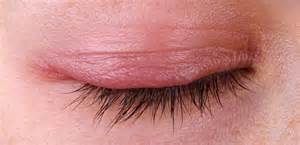Blepharitis or inflammation of the eyelid is a very common condition. It is a dandruff-like scaling of the skin on the lid margins which results in soreness, redness, and crustiness. In its most severe stages, it can affect the lash follicle and cause lashes to fall out.

Notice the crusty debris surrounding some of the eyelashes
Blepharitis usually occurs when the glands leading into the hair follicle at the base of the eyelash secrete too much oil or become clogged or become infected with bacteria.
Blepharitisis not contagious but can be chronic, occurring in conjunction with excessively oily facial skin.

Can appear as if one has “pink eye”
Can cause the eyes to feel dry or gritty
Can cause intermittently blurred vision
Can be the cause of STYES: A stye is essentially a painful pimple on the eyelid caused by a blocked oil gland.
Blepharitis affects both the upper and lower eyelids. The inflammation may be mild and simply consist of redness and scaling of the lid margin or it may be more severe, leading to lash destruction and deformity of the lid.

Both types of blepharitis occur in individuals of all ages, particularly those with abnormally oily skin on the scalp, face, and eyebrows.

Treatment for Blepharitis
To loosen up the matter collected around the eyelashes, place warm compresses on the eye from 5 to 10 minutes.
To alleviate the discomfort associated with blepharitis, the eyelids should be cleansed (rubbed) daily with a mild baby shampoo (no burning) on a wash cloth for 30-45 seconds.
One should try to gently remove any crusting and dry flakes each day with a warm, moist wash cloth.
Individuals with severe blepharitis may require other types of treatment, including antibiotic eye drops or steroidal prescription drops/ointment.
While blepharitis is uncomfortable and often chronic, it is treatable. If you are experiencing dandruff-like scaling of the skin on your eyelid margins, have excessively oily facial skin, or are susceptible to seborrhea, you may have blepharitis.
Avoid rubbing your eyes or exposing them to irritants like chemical fumes, smoke, and smog. Avoid harsh cleaners and cigarette smoke and colored tissue which can further aggravate the sensitive lid area.
If you have experienced any of the symptoms of blepharitis, we recommend that you have an eye examination.
If a problem develops or you have any questions, call our office.
Remember…
If your eyes are red, sore, or scaly, you may have blepharitis.
Blepharitis is not contagious, but it is chronic. Many simple treatments are available to relieve the irritation and discomfort.
If you think you may have blepharitis, we recommend that you have your eyes examined.
Daily Eyelid Hygiene: An Important Step to Healthier Eyes and Fewer Styes
If you have a tendency to get blepharitis or frequent styes, daily eyelid hygiene should be part of your regular cleaning regimen. It should be practiced along with the medical treatment prescribed by your eye care practitioner to alleviate this often chronic problem. Your daily regimen must include:
Either place a warm compress on the eye for a minute or two or let the warm shower run on your closed eyes for the same amount of time.
For about 30-45 seconds, gently rub the margins (edges) of the eyelids with a wash cloth. Use sting-free baby shampoo or a prepared, over-the-counter lid scrub found at your pharmacy. At the very least, you should rub the eyelid margins with just the wash cloth.


Thoroughly rinse both eyelids with warm tap water and pat dry.
Apply any medication prescribed by your eye care practitioner. Your eye care practitioner will inform you how long to continue these procedures. Notify your eye doctor if the condition worsens of fails to improve.
